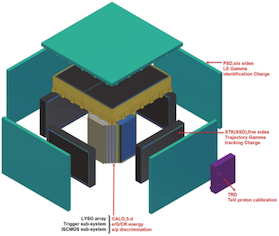
The High Energy cosmic Radiation Detection facility
(HERD) is a module being built with a planned launch in 2027. It will be
installed on China’s Space Station as part of the Chinese Cosmic
Lighthouse Program. It is intended to serve as a dark matter detector, a
cosmic ray instrument, and observatory for high-energy gamma rays. The
HERD detector will be launched
seperately from the space station and installed by a combination of robotic
and space walk activities. Once installed, it would be a permanent
part of the station, mounted with a zenithal pointing (upward
away from the Earth) with an anticipated life span of ten years. The instrument
can be upgraded or, if necessary, replaced during its lifespan.
HERD will contain two instruments, the Calorimeter (CALO) and the
The Transition Radiation Detector (TRD). TRD will be mounted on the
side of the main CALO unit, and will provide TeV energy range proton
calibration data. CALO, in turn, has three components: the cubic main
calorimeter itself, a top-and-four-sides layer silicon strip detector
called STK (the final side is the space station/Earth facing direction from
which no signal would be expected), and an overall encasing in a plastic
scintillation detector known as PSD.
CALO will have two major components: a three dimensional
stack of LYSO “voxels” (volume pixels), each individually
3 cm on each side, assembled as a large array 63 x 63 x 63 cm: 55 radiation
lengths (3 nuclear interaction lengths) deep with roughly 7500 voxels:
The array is arranged as an octogonal column with the octogon-shaped
face oriented upwards (some design documents called for a cubical
array design with even more voxel elements). Each voxel is read out by
a Wavelength Shifting Fiber (WLSF) connected to an image intensifying
CMOS (IsCMOS): readout of a fraction of the vowles with photodetectors as a
parallel independent measurement is also being explored, but not finalized.
The CALO will be topped with micro silicon strip detectors with interleaved
tungsten foil (to convert gamma-rays to electron-positron pairs), known as the
STK. There are seven detector layers, laid in alternating x-y orientations,
with five layers of tungsten foil, with each layer
measuring 65 x 65 cm. The outermost layer of strip detectors discriminates
between incident gamma-rays versus electrons. The entire top assembly STK
collectively provides charge identification, initial trajectory measurement,
back scatter, and some early shower development information on gamma-rays
and electrons entering the instrument. Four sides of the cube have similar
STK design to the top, save with a slightly smaller form (65 x 50 cm) and with
three layers and no tungsten foil: these are used to nucleon
charge and trajectory measurement.
The HERD instrument would be mounted onto an external mounting on the
space station. The station will have three axis orientation controls to
keep it facing Earthward at all times, with HERD mounted with a zenithal
(anti-Earthward) orientation.
The HERD mission intends to study extreme high-energy gamma rays, searching
in particular for a “gamma-ray smoking gun“ spectral signature
anticipated from the annihilation signature of Weakly Interacting Massive
Particles (WIMPs), a candidate dark matter particle candidate. It will also
continue to study the steepening of the cosmic ray spectrum at or around
1 PeV, a known and unresolved issue in current cosmic-ray physics. It will
also provide wide field-of-view guidance to narrow field ground-based
instruments, particularly as the existing Fermi and Agile observatories are
decommissioned during HERD’s anticipated operations period. Finally,
it would will make additional discoveries by opening a new window in
extremely energic gamma-rays beyond prior experiments.